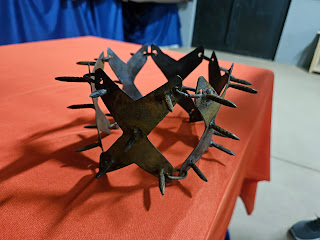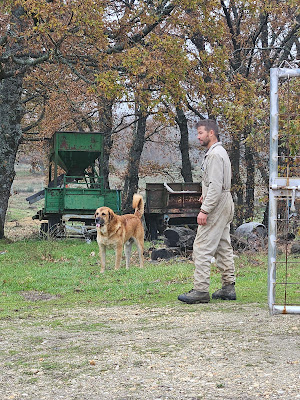Bonding older dogs to sheep.
©Louise Liebenberg (2023)
A question that comes up regularly is how to bond an older
livestock guardian dog LGD) to the livestock if they have not previously been
with livestock? This question however will need a little more clarification as
to why a LGD has not been raised with livestock prior to adulthood? In most
cases, anyone who needs their livestock protected from serious predators will
usually not “waste” their time on a dog that has not been raised with stock.
Most livestock operations will either breed their own replacements and, will
then raise them in a way they feel is most successful for their operation. Very
few of these producers will take a gamble on an unknown adult dog with their
livestock, as it could result in dead and injured stock or a lot of dog management
to try and integrate it in with the livestock.
In some instances, people will take a chance on a rescue,
where very little is known about the history or even the raising practices that
the dog was exposed to. Some of these people are willing to try and, are
prepared to take the time to work with the dog to make a LGD from it. In fact,
my very first LGD was a rehome, had never been raised with sheep before and in
my total ignorance I just placed the dog out with the stock trusting entirely
on instinct and good breeding to kick in despite, no bonding or raising with
the stock. This dog was a saint, and everything worked out very well for us and
she become a very successful LGD. In my naivety I certainly thought that LGD were
very simple. You just take the dog, put him in with sheep and all is good. My
second, and later third rescue/rehome dogs were sheep killers, their instinct
and good breeding did not kick in and they viewed sheep as play objects and
soon realised that lamb tasted good. Despite my firm belief that I could work
with them and get them to a point of reliability with the stock, these dogs
never bonded to the sheep nor became reliable.
I had enough sheep knowledge that I could see that the sheep were never
ever comfortable around either of those dogs, and yet the sheep trusted my
first LGD. Over the years I have certainly come to appreciate the sheep’s
ability to gauge if the dog is trustworthy or not. Following these three dogs,
I soon realised that raising a pup myself, offered the highest chance of
success.
Over the years I have come to believe that it is simply not
all genetics and instinct, a large portion is also raising them in an
environment that will provide them with the most opportunity to learn about
livestock. Just because a pup might be a LGD breed or mix of LGD breeds does
not guarantee that it will be successful. If the dog comes from multiple
generations of non-working lines, its recent ancestors have never even sniffed
a sheep or coyote and no selection has taken place on working ability, then despite
it being a LGD breed, chances are fairly low that this dog will be successful
in its job as a LGD. It is well known in many working breeds, if you do not use
the instinct, you lose it. I have seen generations of show line bred border
collies who have totally lost their instinct to herd sheep. Just because it is
a border collie, does not always mean it will be a working sheepdog.
The loss of instincts can disappear quickly, particularly when breeders focus
on other qualities over those needed for the job. If having a perfect build is
more important to a breeder than working qualities, then you breed away from
the instinct and selection for the other qualities becomes more important.
To ensure selection for good working qualities to pass on to
future generations, breeding dogs do need to be evaluated on their ability to
do their job. Are the protective of the flock, are they bonded, will they chase
off predators, will they watch over newborns, do they have a low prey-drive,
are they trustworthy, attentive and protective of the livestock?
When an older dog is acquired to protect the livestock, it is often not clear
what genetics and instinct are selected for. The next big hurdle is the early
raising and training. As socialization and introduction to sheep at a young age
is important to the development of the pup, an older dog often misses out a
large chunk of this learning experience. It is so much easier to teach a young
child a new language or skill than it is to teach an adult. Although not
impossible, it certainly takes more time. Similarly, the young pup that is
raised with livestock from the start will learn to read the sheep, will learn
to respond to sheep behaviour and body language, they will seek companionship
from the sheep. All this information is freely assimilated by a pup. It is also
for the rancher a lot easier as an 8-week-old pup is not able to physically
harm the sheep, it is easier to trust the pup alone with the sheep than adding
in an adult dog, unsure if it will be safe with the sheep or not. An 18-month-old
dog can do a lot of physical damage to a flock of sheep should some predatory
response be ignited. The process of freely learning, is a concept that works
well in all forms of training and management, whether human or animal.
Developmentally, pups do have phases or windows of learning opportunities that
have been well researched and defined. The ideal window for socialization of
LGD pups to livestock, is typically between 7 and 16 weeks of age. Once again,
it is not impossible to bond an older pup to the sheep, it just becomes more of
a challenge. If the pup is already bonded to the house, yard and kids, the pup
may never want to bond to the sheep.
The question of how to bond an adult dog to the sheep will
require a lot of time, effort and facilitation and the outcome is unknown. With
some dogs, that goes smoothly, and others never do bond with the stock. There is not one method that is a 100%
guarantee that works. It is about working with the dog and offering every
opportunity to bond to the sheep.
What I would recommend one does with an older dog who you
want to attempt to bond to the livestock is the following: I would make a
bonding pen, that has very secure dog proof fencing. I would place 5 or 6 large
adult sheep in that pen, maybe even rams who are accustomed to LGD. It does not
work well if the sheep have never been around LGD before, as their response to
a large dog in their pen, will be complete panic. If you have no sheep that are
used to LGD, it might be worth buying some from an operation who does use LGD.
I would then start by introducing the adult dog on a leash to the sheep. I
would closely monitor the dog’s behaviour and interest in the sheep. If the dog
looks calm and controlled, I will slowly allow the dog to roam around the stock
while I am supervising. I would let the dog drag the leash, if needed I can
quickly intervene. When you must leave, I would either place the dog on a zipline
or in a secure kennel within the bonding pen. I will ensure that the sheep need
to come close to the dog to eat or drink or have some shade in the vicinity of
the dog. I would repeat this process until I feel the dog and sheep are
comfortable with each other. The dog will be tethered or supervised constantly
for the first month of two.
The dog will closely be observed for any good and bad signs. Lunging and
snapping at the sheep would be corrected, fearfulness will be ignored, and
calmness will be quietly praised. Slowly, the time the dog is allowed to roam
freely with the sheep will be extended. I would supervise closely, and slowly
move away and spy on the dog from further away. Camera’s are a nice
technological aid in being able to spy on the dog. Provided the dog shows no
aggressive or predatory reaction, I would continue this path. I will only allow
the dog to be free overnight and not supervised, if I am convinced the sheep
will be safe, they are calm, and the dogs is relaxed and comfortable around the
stock. Once this has been achieved, I will expand the pasture and add in a few
more sheep. Watching closely how the sheep and dog interact. With a pup, from
the time is a pup to the time it is going out with the flock is usually a
process of around 8 to 10 months. I would be looking at a similar timeline for
a newly introduced adult dog. Often people make the mistake of trusting the dog
to quickly, do take the time to ensure both dog and sheep are comfortable in
their presence. Watch for signs of the dog being attentive toward the sheep.
The most important quality initially is simply for the dog to be trustworthy
and not harm the sheep in any way. Playing with the stock might not seem harmful,
but it is. One really does need to pay attention to the details of the
behaviour for both the dog and the stock when introducing an adult who has
never been with livestock before. I have
written multiple articles on bonding and on looking for good and warning signs,
when working with an older dog, it might be a good idea to reread some of those
articles.














